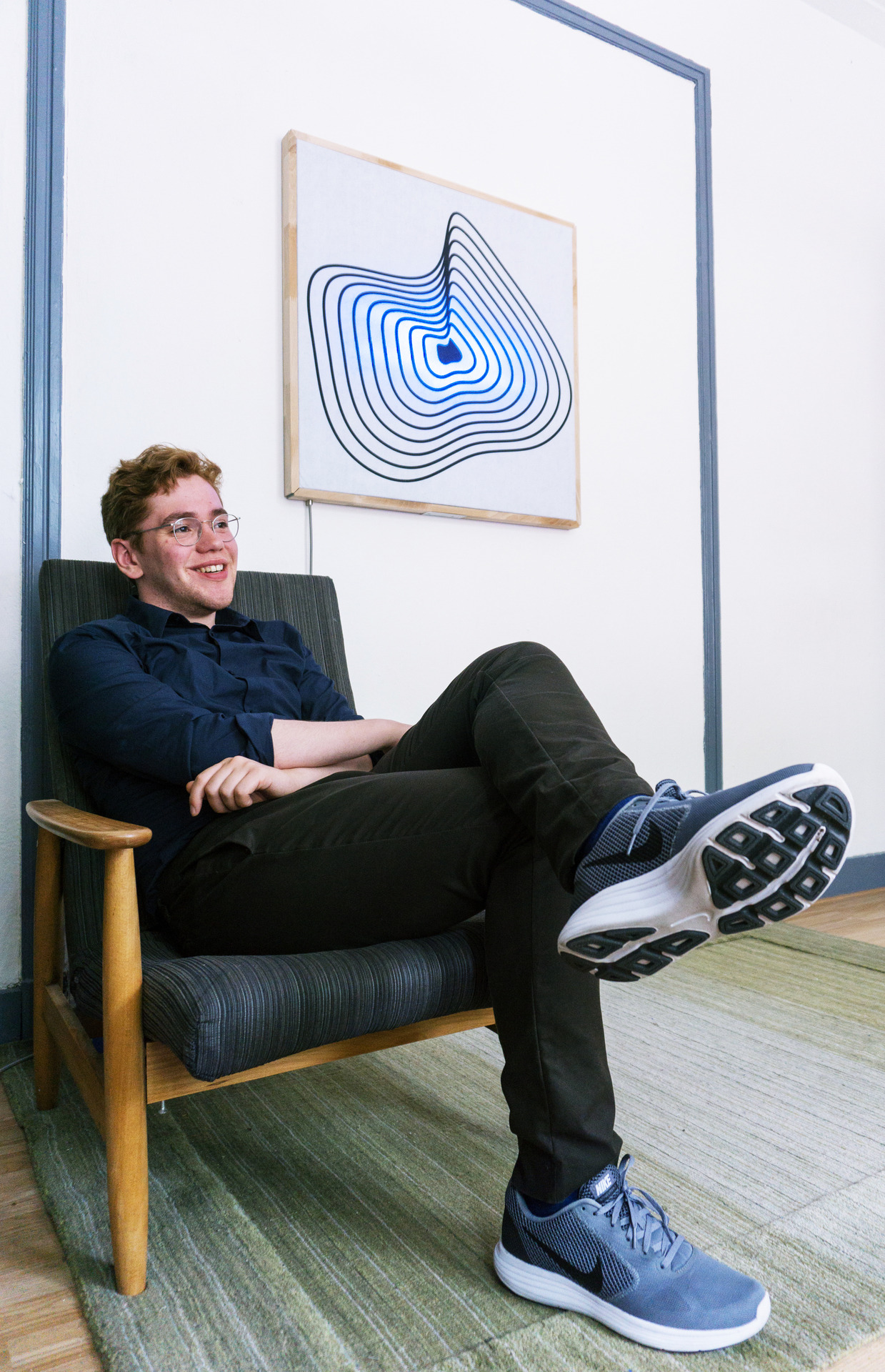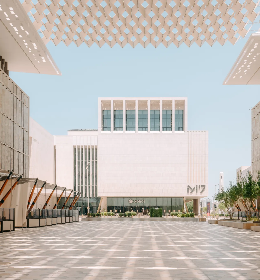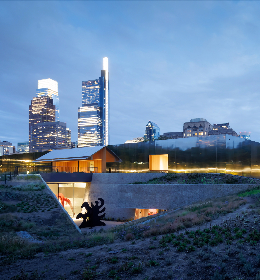It was a chance meeting as he stopped to view my unofficial nomadic pavilion one evening — a series of projections of artists’ works I was presenting on the exterior walls of the Doge’s Palace. He explained that his work was on show at Venice Design 2019, now in its 4th edition, installed at the Palazzo Michiel.
The next day, with my curiosity piqued, I headed over to Palazzo Michiel where 60 designers hailing from 30 different countries are presenting work in a variety of formats. Venice Design includes intelligent and interactive design, design as artistic practice, beyond aesthetics, with emphasis on human-centered work conveying topics as diverse as gender identity in clothing to solving air pollution, and even a table setting with plates and cutlery as percussion instruments, where one may share a meal in sound. Van Der Horst’s work, Onda, with both a functional and aesthetic intention, was in the central room of the Palazzo, presenting undulating concentric waves on fabric with a clean design image stretched and framed, as if it were a painting hung on a wall.
Onda is constructed from textile coated with copper-doped titanium dioxide, which acts as an air purifier. This unique textile work uses daylight in a miracle transposition turning soot and other forms of pollution into none other than water molecules. The work is meant to be touched when it is installed in the home, as the action of gently pressing into the fabric activates a light, which in a semi-strobe fashion indicates poor air quality or, in contrast, a flickering like a candle flame, which indicates that the air is clean. This flickering ultraviolet light also provides extra purification when it is activated, boosting the air quality when light pressure is applied.
Joca Van Der Horst studied at Eindhoven University of Technology and Rotterdam Arts Academy, a perfect combination of knowledge for work of this kind that traverses the boundaries of fine art and design. Van Der Horst explained a little about his background to me:“ I found a direction in which I work on the verge of art, technology and interaction design. I am interested in how people interact with technology, and how this same technology can be a way to highlight a particular topic. In the case of Onda, that is the air quality in our home, not just by cleaning it, but also by showing it when people touch the fabric. What I like about the design community in the Netherlands is that people love to collaborate across disciplines. I learned a lot from working with engineers, fashion students and the like. They all offer a different perspective to look at the world.”

I found the name Onda intriguing and asked him about its origin and the inspiration behind this work. “The interesting thing here is that the air purification process is invisible and silent. So what I wanted to do with Onda was to create a visible metaphor for the pure air. I found the idea of waves appealing, because they have this connection with freshness. At the same time, the nanoparticles get their energy from light, which travels in waves through the air. The name and the pattern on the prototype are the result of that thought, as "onda" is Portuguese for wave and the pattern is based on the graph for a heavily transformed sine formula, the mathematical way to describe a wave.” His response signals an elegant and lively interpretation and connection between design, concept, and realization; its simplicity makes it appear as a logical outgrowth of these inherent factors.
His air purifier was also building upon work that was being created around him: “During my research I found out about a team at another department of the university, working on nanocoatings that clean the air using visible light. These were applied on concrete, but I thought that using these coatings on a textile painting could be a way to introduce this technology to a broader audience.” His inspiration from the research of a group in another department shows the importance and effectiveness of putting artists, designers, scientists, and researchers in close proximity, with ideas and innovations growing as naturally amongst them as lichen on a tree.
“During the process towards making Onda, I became more and more interested in air purification. I was doing this project in the smart textiles department of my university and saw a stark contrast between the utilitarian air purifiers on the market, and how subtly technology can be embedded in the home when it is integrated in fabric. It is remarkable to see that there is a lot of attention to air quality in the public space, but there is not so much innovation yet for the improvement of air quality in the home,” explains Van Der Horst. In reflecting upon my own experience living in different countries, I immediately think of Shanghai where I lived as an international teacher, or even Beijing, as a potential market for these attractive air purifiers, which allow for beauty to arrive with practicality into the home. I remember a few years ago, the wave of interest from international teachers in Shanghai to obtain air purifiers for their homes, a near necessity at that point with the daily air quality index reaching well over 500. Air purifiers were scarce and there were even waiting lists for the latest affordable models.
I wanted to also know if there were some works that Van Der Horst found particularly engaging — he mentioned: “The PM 2.5 pollution soap bars by Jihee Moon of the Royal College of Art are super interesting. In this project, air pollution is made visible by collecting it in special bars of soap.”
When asked about his particular vision for design, Van Der Horst commented, “In the book Looks Good Feels Good Is Good, the designer Amy Franceschini describes a design process with an analogy which I find really inspiring for the way I want to work: 'Our approach is a sort of journalism. We question the world around us and the systems that are part of that'.”
It seems that often artists and designers are influenced by chance and close proximity of other creative minds. Van Der Horst confirms this, while relating the accidental seed of inspiration planted for Onda: "I found the research about the air purifying nano particles and this discovery was then the start of a whole new project. Sometimes it might be just as simple as running into the right person, or PDF! On the other hand, this might be chance, but you can control it to some extent by being in an environment where these kind of things can happen and do happen often. Eindhoven is such a place.”
There seem to be a variety of routes that creative people take to reach the level and opportunity that Venice presents. I asked Van Der Horst how he ended up participating in this prestigious exhibition: “I got an invitation to show Onda at the exhibition. Thanks to support from the university in Eindhoven and the Creative Industries Fund NL, I was able to participate. Venice Design is a great initiative as it connects young designers from all over the world, and it is a fantastic platform to show Onda to a diverse and interested audience. At the moment Onda is still a prototype, and this exhibition might just be the chance to take the next step, for example by starting a small scale production of it with the help of a partner.” I look forward to having an Onda of my own someday, to ensure clean air and to support the bridge between art, design, and technology.
More about Joca van der Horst here.
By Anne Murray









